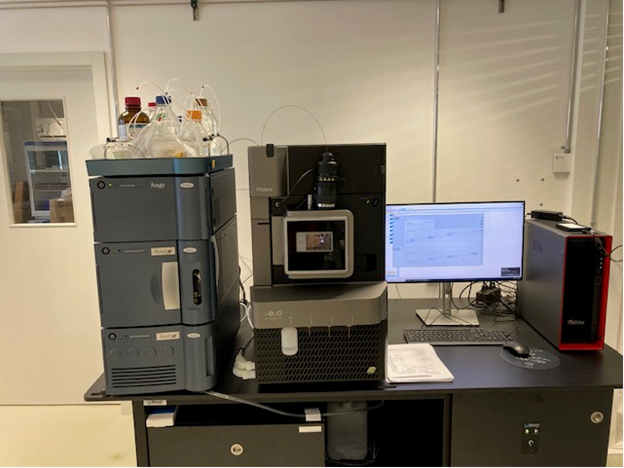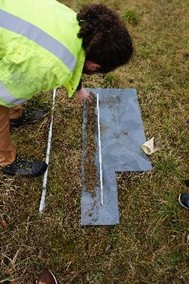
June 2025
Welcome to the HSE Newsletter, which is published twice a year and features some selected highlights for the HSE Unit. You can find the other editions here or in the side menu.
We thank the contributors and encourage anyone who has a newsworthy story to share it with us at hse-comms@cern.ch. We will then publish it on the most appropriate channel, including the CERN Bulletin or the HSE website.
Happy reading!
Contents
- Behind the scenes of the FCC Feasibility Study: HSE's role in shaping CERN’s future
- CFRS welcomes five new firefighters in 2025. Meet the new recruits!
- Soil, science and sunshine: The OpenSkyLab’s Spring awakening
- Cutting-edge new suits for CERN’s Fire and Rescue Service
- A new “colleague” joins the HSE-ENV Environmental Monitoring (EM) Lab team!
- Before the build: saving top quality soil, and some 200 orchids, in Prévessin
Behind the scenes of the FCC Feasibility Study: HSE's role in shaping CERN’s future
Highlighting our Unit’s contributions to one of CERN’s most ambitious projects yet
After four years of effort and perseverance, the FCC Feasibility Study concluded on 31 March 2025 with the release of its final report, which will be assessed by the CERN Council in the coming months and serve as input for the European Strategy for Particle Physics update in 2026. The report spans three volumes: Physics, Experiments, Detectors - Accelerators,Technical Infrastructure and Safety - and Civil Engineering, Implementation and Sustainability. HSE colleagues, such as Luisa Ulrici (ENV), André Henriques (OHS) and Markus Widorski (RP) have been deeply involved in shaping the FCC feasibility study, with contributions in the domains of radiation protection, evacuation, fire safety, cryogenic safety and the responsible handling of civil engineering challenges such as excavation materials. In this interview we find out more about the questions they tackled, the expertise they brought, and the collaborative efforts that placed Safety and sustainability at the core of the FCC feasibility study.
Click to read what each had to say about this landmark project
Markus Widorski(RP)
Q: Markus, you contributed to the Radiation Protection aspects of the study, first of all how did you go about assessing RP challenges in what is a theoretical context?
MW - Before starting an assessment, we need to identify the potential radiation hazards. As the facility parameters are developed and the conceptual and technical design of systems and components evolves, we identify and prioritise the aspects that should be addressed first. The assessments are then performed by scaling from past or present facilities, or through conducting dedicated radiation studies, very often based on FLUKA Monte Carlo simulations. It is an iterative process where one must carefully judge the right time to launch a study and the level of detail that is appropriate at a specific stage of the project, especially as the provided input parameters may be still incomplete or uncertain. Beside quantitative assessments, qualitative input to the discussions is essential as it will guide designers and integrators towards solutions that will already be close to an optimised and acceptable design. With time, stakeholders gain awareness and understanding of what constitutes a good design in terms of radiation protection. At this stage of the FCC project, priorities are set on questions that affect civil engineering and integration, but also systems that are relevant to the impact on the environment or the maintainability of the installation. We take a proactive approach to flag potential issues and include our experience from past and existing facilities, considering the current context and tools we now have at our disposal.
Q: In your view, what are the main RP considerations for such an ambitious project?
MW - From a radiation protection perspective, the main considerations in such a project are to ensure that the impact on the public and the environment remain negligible, and the infrastructure is optimised to reduce doses received by personnel intervening for maintenance on the different parts of the facility. Consequently, some design decisions made very early on in the project phase will have a relevant impact on radiological considerations. For example, the entire underground civil engineering infrastructure layout is the first to be fully defined well before the design of individual accelerator systems is finalised. All systems that are linked to an environmental impact, such as ventilation or water circuits, must be addressed equally early.
Q: What are the main radiation protection challenges posed by a collider of this scale and energy?
MW - The FCC, in its initial phase as a lepton collider, is much more than just an upgraded LEP. The differences in size and operating parameters are substantial, as are the technical challenges. FCC-ee will operate at much larger beam currents and at higher energy. This will generate different kinds and levels of radiation and activation. One aspect is the high energetic synchrotron radiation that becomes particularly relevant for radiation protection at the last stage of FCC-ee and that has a widespread effect over the entire accelerator. Regarding the size of the machine, a well-studied design and optimised material selection will be essential to minimise the activation of components that will need to be stored or eliminated after the lifetime of the FCC-ee. Another example is the high-power photon beams that will emerge from the interaction points, and which need to be safely absorbed. These “beamstrahlung dumps” represent an engineering challenge, beside their technical feasibility, to comply with radiation protection requirements. However, we can say that one can be confident that the radiological challenges at FCC-ee can be adequately addressed and overcome to allow a safe operation.
Q: And finally, what insights have you gained from participating in this process?
MW - A coordinated and effective project structure is essential for a successful design that considers safety questions such as radiation protection from the start. Understanding and knowing the structures, stakeholders and key persons driving design decisions are important to address and balance the competing requirements for feasibility, performance, safety, and cost. Sharing experience and knowledge is also critical to develop innovative and feasible solutions to the challenges encountered.
André Henriques (OHS)
Q: Andre, for your part you contributed to the general Safety aspects of the study. To start with, what are the key safety challenges during the FCC’s construction and eventual operation?
AH - Simply the sheer size of the facility. We now have more than 10km in between access shafts. Evacuation by foot is no longer an option as in the LHC (3.5 km), which means we need to develop an evacuation concept that relies on support of mechanical means of transport during an emergency. This is something new to us and requires an extensive ‘what if’ scenario analysis.
Q: What are the biggest unknowns or “grey areas” in terms of safety planning for a facility like the FCC?
AH: The maturity of the technical systems. Many of the accelerator components such as the SRF cryomodules or klystrons are still under development, any modification to their design might have an impact on the current safety concept. This upcoming three years (pre-TDR) will be crucial to freeze the baseline of the accelerators & detectors so that we are able to update and/or amend the safety concept in the event of a green light from Council in 2028.
Q: What insights have you gained from participating in this process?
AH - I am lucky to have been involved in the FCC study since its kick-off in 2014. I’ve seen several versions, from a two-tunnel proposal to underground passages and also (even for a very limited time) an idea of having a ‘metro’. This process was extremely enlightening for me as you are able to grasp what it takes to build the world’s largest (and safest) infrastructure in the world.
Luisa Ulrici (ENV)
Q: Luisa, you delved into the fascinating topic of civil engineering & excavation materials. Can you tell us more about this?
LU – It is estimated that the FCC excavation work will generate approximately 6.3 million cubic metres of excavated material, equal to approximately 8.2 million cubic metres of expanded material over nearly a decade. To give an analogy, this would correspond in volume to about 3 Cheops pyramids.
The material extracted will mostly comprise different types of heterogeneous soft rocks, called molasse (95%), along with limestone (3%) and quaternary deposits (2%).
The molasse is formed by a series of horizontal layers of cemented and silty sandstone interspersed with layers of marl and argillaceous rocks. Geogenic anomalies such as the presence of natural hydrocarbons or enhanced concentration of metals including nickel and chromium may exist naturally in varying quantities in parts of the various molasse layers.
The materials that would be extracted during the excavation are essentially inert materials. They can be reused on the same site from which they are extracted or can be recovered. Reuse and recovery are two ways of preserving natural resources and, directly and indirectly, facilitating the achievement of the regulatory objectives and satisfying circular economy principles. Excavated materials are a source of mineral resources for the region, which must be managed in terms of their quantity and quality.
Q: How did you go about evaluating the various facets of the management of these excavated materials?
LU - During the definition of the document “Excavation material management strategy” for the FCC feasibility study (2021-2024), the safety considerations and the related risk management approach were taken into account. When preparing a management plan for these materials, particular attention must be paid to the management of both technical and non-technical risks, which have a direct effect on limiting costs, optimising transport and avoiding compromising the schedule. In the case of the FCC and for the technical risks of the external context, one can underline those related to geological uncertainties such as the positioning of the top of the molasse, its variability and the presence of hydrocarbons of geogenic origin which can modify the volumes and properties of the different classes of excavated materials. Concerning the risks linked to the impacts of the works on the human and natural environments, one can note the question of the availability areas and infrastructures required for the storage, treatment and transport of excavated materials close to the 8 access sites. Finally, for what concerns non-technical risks, the long duration of the project studies and work might be impacted by regulatory changes (including the question of cross-border transport) and uncertainties on the durability of the recovery sectors.
Q: How is the potential reuse, transport, or disposal of excavation materials assessed and planned?
LU - The FCC offers an opportunity to develop innovative approaches for the management of excavated materials, given the sufficient lead time before its potential realisation. For this reason, the study invested early on in launching research and development of new technologies and solutions that have the potential to reduce the amount of waste that needs to be transported to deposit sites.
Among the identified pathways, the most likely to be realised are the use for development requirements within the project (e.g., FCC worksite tracks, landscaping purposes, etc.), the use in earthwork (backfilling of quarries and mines and rewilding), the use of the limestone fraction in concrete production and stabilisation of structures and the use of the sand fraction in concrete production. In addition to these traditional reuse cases, innovative reuse pathways were identified during the ‘Mining the Future’ international competition that took place in 2021 and 2022. Some of the innovative solutions are now being integrated into a unique design and evaluated by means of projects. This is the case of the transformation of the molasse into functional soil for applications in the development of brownfield sites, urban recreational areas and forest areas, as well as improving the fertility of acidified land and/or as technical areas along the verges of roads and motorways (pollutant filtration). This is currently tested at the OpenSkyLab, the field located in Cessy, just beside LHC P5. It is estimated that about 2 million cubic metres (about 4 million tonnes) of excavated materials could be reused via this pathway, provided the appropriate areas are identified.
Q: What are the main challenges that you faced in assessing this topic for the future collider?
LU - The strategy for the management of excavated materials has been developed in the framework of the European FCCIS (FCC Innovation Study) project in collaboration with the Centre for Tunnel Studies (CETU, France), the Centre for Studies and Expertise on Risks, the Environment, Mobility and Urban Planning (Cerema, France), Montanuniversität Leoben (MUL, Austria) and in consultation with the Canton of Geneva’s department of geology, soil and waste (GESDEC), along with other partners. The main challenge was to integrate the different regulatory frameworks in France and Switzerland and the different approaches to the management of the excavated materials. This is needed as the proposed tunnel location straddles the French-Swiss border at several locations. This reminded me about the first phases of the discussions about the Tripartite agreement in radiation protection, where the radioactive waste I was managing at the time was subject to different legislation in France and Switzerland. Actually, I got inspired by the solution found for the radioactive waste management in the Tripartite agreement when proposing the adoption of the principle of each State managing the equivalent mass of soil excavated on its territory. This adjustment, which remains to be agreed with the two Host States in association with CERN, would make it possible to deal with the small enclaves that cannot be managed by the tunnel boring machines operation without changing the principle of division laid down in the Basel Convention.
Q: And to close, what insights have you gained from participating in this process?
LU - The main insight gained during the process of definition of the excavation material management strategy is that, given the international nature of the project, an agreement between CERN, Switzerland and France is necessary to create a single, indivisible authorisation framework for the project consistent with the transboundary context. Adopting this framework will result in appropriate regulatory conditions for the management of excavated materials.
Meet the new CFRS recruits!
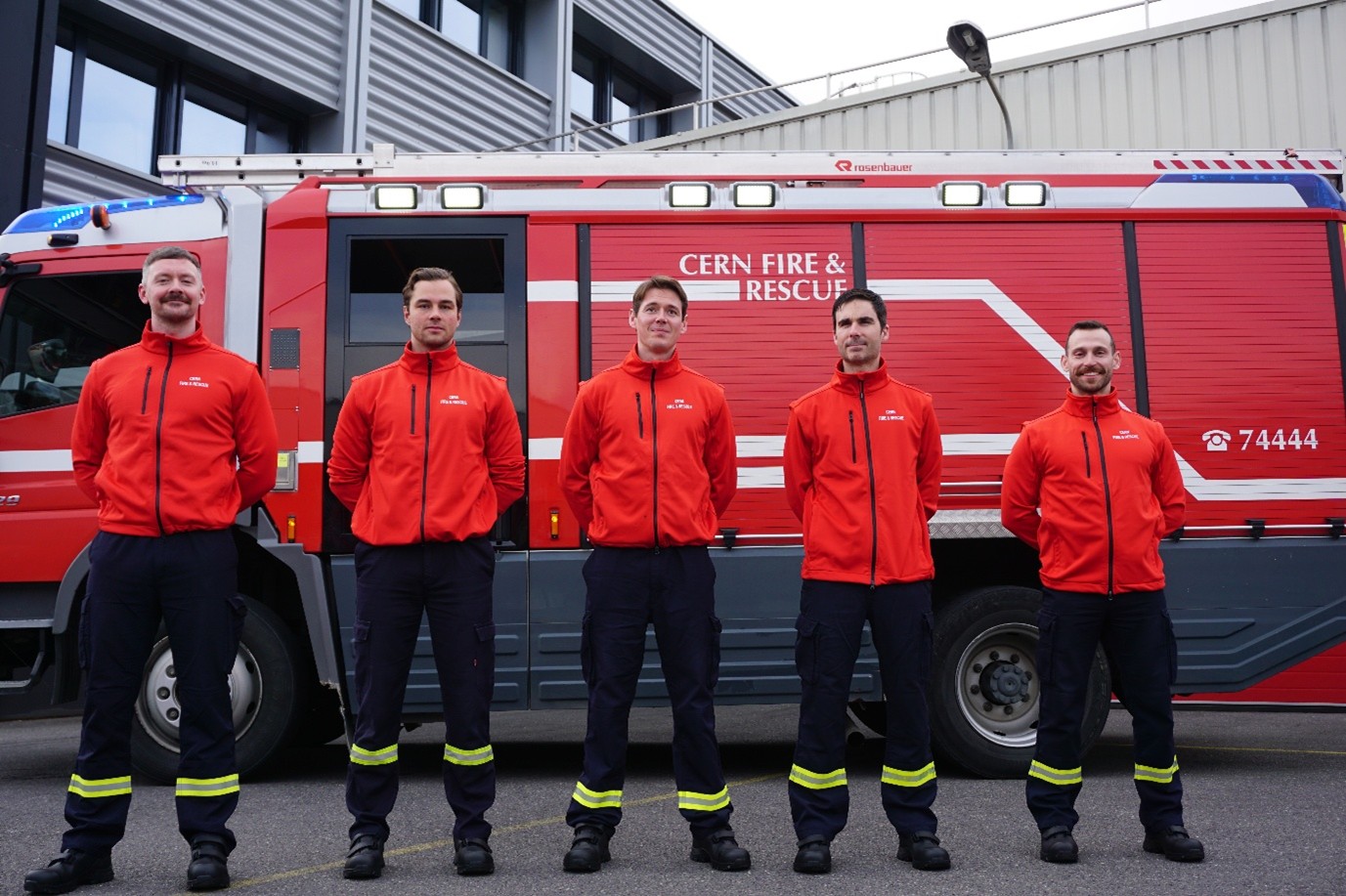
From left to right, our new firefighter colleagues: Rory, Mikko, Adam, Juan Carlos, and Tiago
As the CFRS class of 2025 complete their induction and graduate from their red to blue uniforms, we sat down with them for a “very serious” chat, to get to know them a little better… Each gave a brief introduction of themselves, before answering one of our randomly assigned questions.
Click here to see how the "serious interview" unfolded...
Mikko Myllari, Finland, formerly working at Pirkanmaan rescue department
First impression: Noticing how confused we all were at this simple Finnish place name, Mikko proceeded to spell out ‘Pirkanmaan’ in the NATO phonetic alphabet.
Q: Mikko, what is the biggest difference you have noticed between CFRS and your previous job?
MM - The biggest difference to me is that this is more of an industrial firefighting environment, whilst previously I worked for the public sector in an urban setting. The mindset is very different.
Here we focus on the small area inside the CERN perimeter and try to get to know its topography as well as possible. We know the buildings, the risks, the entry points, etc.
In the public services, in Finland at least, you cover a much, much larger area. You do not know the location as well, so you’re always discovering new locations as you go, and you never quite know what you will encounter.
There are also new hazards here of course, such as radiation, cryogenics and high voltage.
The number of different nationalities is also a big change. Though I worked for some time on a UNIFIL peacekeeping operation in Lebanon, for the UN, which was a similar international environment with 20-30 nationalities.
Juan Carlos Goujon, Spain, formerly working at Montgomery County fire and rescue department, Maryland, USA
First impression: Juan Carlos’ accent becomes profoundly and convincingly American when he says the name of his previous service. This was very unexpected.
Q: Juan Carlos, can you tell us an anecdote?
JCG - This is a hard one!
Others - Tell them about the SAAS … no, about the breakfast …
JCG - Ah breakfast! That’s a good idea.
On our selection day, we asked about breakfast: are we going to get breakfast and what kind of breakfast will it be? Our expectations were very high. We firefighters take breakfast very seriously. In fact breakfast is perhaps one of the top two priorities in our life, after getting up in the morning and breathing.
We were assured, yes, there would be a “French breakfast” for everybody as part of our selection day. This was a new idea to us at the time, nobody really knew what a French breakfast meant, but ok, we were reassured.
However, when we arrived, we saw these absolutely tiny pastries – I think you might be familiar with them – a tiny, coin sized muffin! It was ok, but we were quite shocked, perhaps we needed about twenty each just to get started?!
What was so nice however, was that upon our apparent disappointment, Stephanie Sullwald (our HR representative) brought us all proper pastries. She saw the sadness in our faces, our anxiety, and treated us all to a proper breakfast.
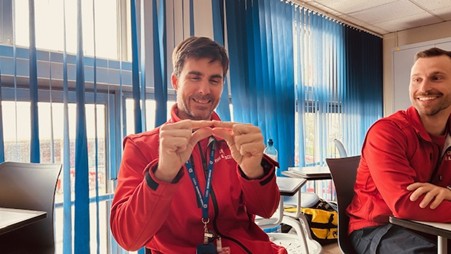
Juan Carlos shows us the incredible size of the breakfast muffins.
Tiago Pinheiro Fonseca, Portugal, formerly working at the Regimento de Sapadores Bombeiros in the beautiful city of Porto
First impression: Tiago places great emphasis on the word beautiful, and seems to gesture toward the grey, rainy Geneva sky…
Q: Tiago, what has been the most unexpected thing about your time at CERN so far?
TPF - Actually, that people are so warm and welcoming.
In Portugal the system is very different from here, firefighting is much more closely linked to its military history. As you can see from the word “regimento” – regiment – in the name of my previous unit.
So, the mindset in Portugal is still quite tough and military. During the first week here where everybody treats you like a proper grown-up firefighter and welcomes you nicely, which was quite strange!
I felt really welcomed; my heart is full. This is the most surprising difference I noticed during my first few days here.
Adam Varey, UK, formerly working at Lancashire fire and rescue service based in Chorley
First Impression: Adam is from Lancashire, and as such, must be a “good’un”. Coincidentally, Rob’s family are from near Chorley, and we immediately feel better knowing people like Adam are looking out for them.
Q: Is there any new equipment you’ve learned how to use since joining CFRS?
AV - Oh definitely. It’s a lot more extinguisher based here than back at home. By that I don’t just mean fire extinguishers, I mean extinguishing foam - or CAFS for short as it is known.
Back home, almost everything was water based. Wherever it was safe to do so, we would put out a fire using water as our first resort. Using CAFS has been completely new to me.
The hierarchy of firefighting systems at CERN is CO2 first, then CAFS, then water as a last resort – this is a big change to me! So in terms of equipment, all the CAFS stuff has been a big change.
Of course, discerning HSE newsletter readers already know all about the advantages of CFAS from the December 2024 feature on this topic.
Rory Burton, Scotland (UK), formerly working at the Scottish fire and rescue service based in Tollcross fire station
First Impression: It can be difficult to describe feelings in your non-native language, so this question was adapted for non-native English speakers. Rory followed this instruction, providing us a helpful translation of his original Scottish.
Q: Rory, in three words: how does it feel to be graduating to the blue uniform? You can use your native language if it is easier to do so.
RB - Braw. Bonnie. Proud.
Braw, that’s like a “warm good”. It’s important to roll the ‘r’.
Bonnie, that’s my mum’s name, and it also means ‘nice’ or ‘beautiful’.
Then proud, that’s like the English, except in Scottish it’s pronounced “pruud”. I think everyone agrees with that one, right?
All - Aye!
For readers: that’s the typical Scottish word to show agreement, said with energy!
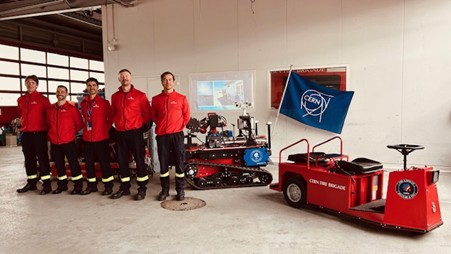
The newcomers next to the CFRS’s latest new equipment
Soil, science and sunshine: The OpenSkyLab’s Spring awakening
Warm Spring days and good weather conditions have been welcome, as activity ramps up at the OpenSkyLab, an experimental field station of about 10 000 m2 located at LHC point 5 in Cessy, France. OpenSkyLab is a project carried out in the context of the FCC study whose primary objective is to test the feasibility of converting representative quantities of molasse from previous CERN projects into functional soil for various types of applications and to assess the yield potential of the constructed plant-soil systems. The trial will also identify the plants best suited to this type of soil.
We met up with the project team in HSE-ENV, Luisa Ulrici (project leader), Corentin Pueyo (civil engineer) and Christiana Staudinger (plant-soil interactions) to find out more about what has been happening.
Click for the full story

Caption: An aerial view of the OpenSkyLab
Q: Luisa, can you tell us how the idea for the OpenSkyLab came about, and why it’s such a timely and innovative project for CERN and beyond?
LU - The idea started during the development of the FCC excavated materials management strategy. Indeed, as part of the feasibility study for the Future Circular Collider (FCC) research infrastructure, it is anticipated that approximately 16 million tons of excavation materials would be generated. The international Mining the Future® competition, launched By CERN in 2021 aimed to find innovative solutions for the management of excavated materials, and in particular the molasse, a soft heterogeneous rock. Although just one of the four final proposals was ultimately declared winner of the contest, CERN continued to develop synergies between the ideas submitted by the four finalists.
in 2024 CERN launched the OpenSkyLab project that focusses on local reuse of the excavated materials and explores the possibilities of recovering excavated materials for farming, reforestation and other local applications. Its purpose is to provide scientific evidence of the feasibility of producing fertile soil from molasse under monitored conditions. This project is based on an international collaboration bringing together universities, research institutes and companies specialised in soil engineering and agronomy.
Q: Corentin, from your civil engineer’s perspective, what are the main challenges encountered so far and how have you overcome them?
CP - Believe it or not, one of the main challenges was discovering how excavated materials were managed in past projects. During the construction of LEP (the Large Electron-Positron Collider) in the 1980s, molasse from tunneling was deposited at what is now the OpenSkyLab site. This created an impermeable layer just below the surface topsoil, blocking natural drainage and causing water to stagnate above. Ironically, this is precisely what the project aims to avoid—by designing layered substrates that allow for balanced water flow and retention, among other ecosystem functions. Thanks to the installation of a dedicated drainage system below the experimental cells, we managed to solve this issue, despite a small delay and additional costs. This experience serves as a clear reminder that past management strategies have not always been effective and reinforces our commitment to improving soil conditions through better, sustainable practices.
Q: Luisa, spring seems to be a critical time for you at the site — what were the main activities you carried out this April, and how did the weather play a role?
LU - Well, spring is “the” season for plants and the entire process of the field preparation carried out in autumn/winter 2024 for the creation of the different test plots, creating appropriate drainage, mixing and bringing in the molasse and installing the sensors had to be finalised in time for the start of the agronomical activities. We started spreading bovine manure (in French “le fumier”) … a rather smelly activity that had to be performed by hand so as not to compromise the “soft” molasse substrate by driving over it with heavy engines. Then we seeded the different plant and grass species that were carefully selected by Christiana and the rest of the Consortium. In the meantime, the trees had been grown in our “nursery” and on our test hedgerows. The weather plays a fundamental role in all these activities that need to be conducted before the first hot days arrive but cannot be easily carried out if it is raining heavily.
Q: Christiana, what types of plants are you testing, and how do you decide which species might thrive in this constructed soil?
CS - Our selection process of plants (and landscape features, i.e. hedgerows) considers three aspects: the plants’ ability to withstand the specific conditions of our constructed soils, their potential to contribute positively to soil health and stability, and their ability to result in a positive outcome for the region in terms of biodiversity, climate resilience and valorisation through local value chains.
We primarily test plant species that have physiological adaptations to tolerate alkaline, calcareous, and nutrient-poor conditions, as well as intermittent drought periods. In addition to individual species, we also examine mixtures of plants, where the traits of one species support the survival and growth of others. A well-known example of this synergy is the association of legume and grass species. The legumes we chose are different clover species or the commonly occuring Lotus corniculatus, which fix atmospheric nitrogen through a symbiosis with bacteria. Grasses on the other hand are dependent on nitrogen from the soil to thrive and when legumes grow nearby, the amount of nitrogen available in the soil is higher. In return, grasses protect the soil with their roots, reducing erosion and increasing soil aeration, which is required for effective nitrogen fixation.
Beyond physiological tolerance, we are interested in plants that can store carbon in the soil and help develop healthy soil structure within the first few years after planting. This is important for overall soil health and functionality.
We also consider plants that can add value locally. For example, Miscanthus is a type of grass that grows well on less fertile soils. Its stalks can be used for animal bedding, packaging, insulation, or lightweight concrete. Growing Miscanthus over several years can also lower soil pH, which is beneficial because high pH levels can cause nutrient deficiencies.
Q: Luisa, there’s mention of "fumier du fermier de Ferney" (the manure from the farmer in Ferney) — how did your team manage to turn a (let's say) “earthy” experience into a productive and enjoyable afternoon?
LU - Collaboration is the key to success: during the afternoon all participants appreciated the explanations provided by Christiana and by our partner experts in soil formation and plant-soil interactions.
Q: And you’ve built quite a unique, international, and interdisciplinary team for this project. How important is collaboration in a project like this, and what have you learned from working across such diverse fields?
LU - Indeed, the OpenSkyLab profits from the interdisciplinary competences brought by several partners from academia, research institutes and industry. These span several scientific domains, including pedology, biology, hydrogeology and agronomy which are not normally found in CERN’s “core-business”. It is very stimulating and enriching to collaborate with such a wide variety of specialists, not only in the field of research, but also for the techniques used and the different approaches to problem-solving.
Being a physicist, I sometimes feel like an “alien” when the experts discuss plant-nutrient interaction or mention soil-plasma, but I feel privileged to be learning all the time!
Q: Christiana, on a lighter note I heard there’s even a bit of Saharan phosphorus in the mix — how does that unexpected natural phenomenon impact your experiments?
CS - Desert dust can significantly influence the biogeochemistry of phosphorus in terrestrial ecosystems, especially when these systems are strongly phosphorus-limited. Our constructed soils are not extremely limited in phosphorus, but still present a relatively low phosphorus availability, so any additional nutrient input is of interest. However, the phosphorus transported via aeolian dust is unlikely to be immediately accessible to plants, in part due to the alkaline soil pH I mentioned earlier. Over time, root exudates and the gradual export of plant biomass can help make this phosphorus more mobile and available through soil acidification and chemical processes.
Q: Luisa, to close what are the next big steps or milestones for the OpenSkyLab over the coming months?
LU - We will have the first results at the end of this summer 2025 regarding the different cultures tested and the plant-soil interactions. Then, in 2026, we will verify the soil reconstruction, and we will compare the different methods that we applied for the mixing of the molasse with the compost. In 2027, we will have the agronomical and biological results from the different cultures, and we will build models to be able to scale to different sizes and plots. You can follow the project and its progress on https://openskylab.web.cern.ch/
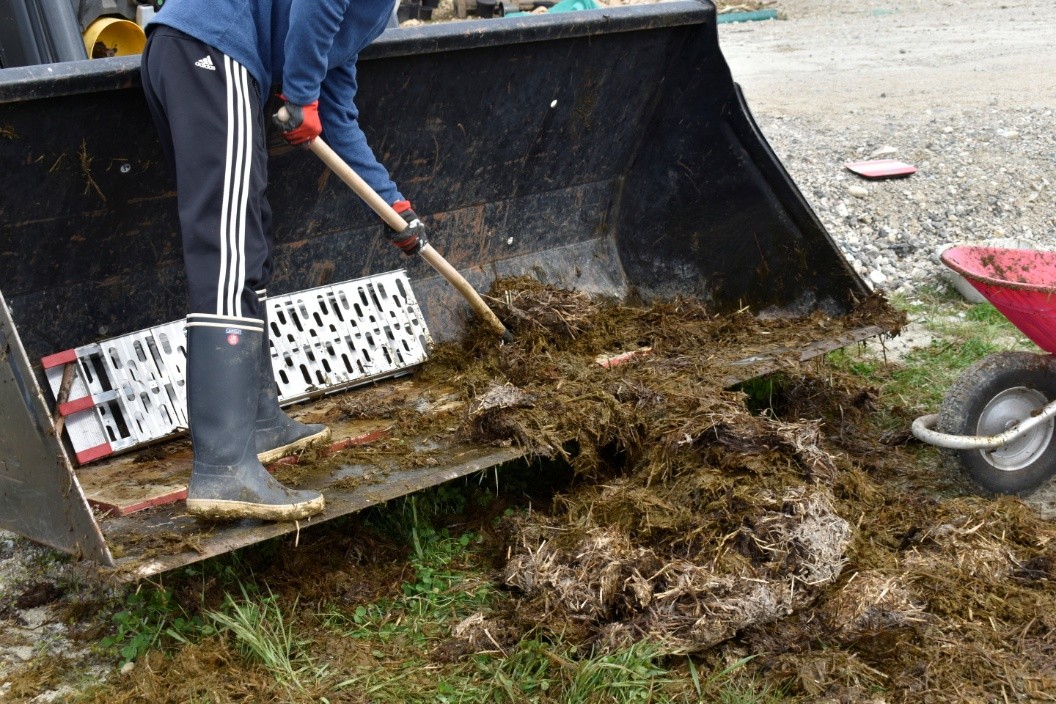
Caption: It’s a smelly activity, but somebody’s got to do it…
New cutting-edge suits for CERN’s Fire and Rescue Service
|
The CERN Fire and Rescue Service will retire their famous orange suits this year for a far more modern, safe and versatile alternative. You may notice a new look for CERN’s firefighters this spring. Orange is out, and a state-of-the-art new design is in. Incorporating nanomaterials, an integrated harness, and no more than 14 pockets. The suit is designed to meet the exacting requirements of the CFRS and its reputation as a world-class firefighting unit. CFRS-PPE Working group member and fire officer Miikka Leinonen explains the rationale behind the change, and what edge these new suits give to the Service’s capabilities. |
|
Click to see the story behind the suits:
Q: Miikka, why make this change, and why now?
ML - This year, a large number of old suits were due for replacement. It was the ideal time to assess what we needed from our suits and determine whether an upgrade was necessary. After gathering feedback from users about the current suits, we decided to explore the market.
Additionally, there is now better industry-wide awareness of how exposure to carcinogens or dangerous substances during interventions can harm firefighters in the long term. Modern suits incorporate new material technologies which can reduce this exposure and associated risks.
Within a dedicated working group including Sebastien Pourcelot, Will Newman, Maria Angeles Verdu Roque and Javier Cuadrado, we evaluated more than 10 different fire suits from multiple manufacturers and several different countries over this 18-month project.
Q: What are the advantages of this new suit for the CFRS?
ML - CFRS firefighters have to carry a lot of specialised equipment in their personal gear, such as radiation- and gas meters, which is not the case for conventional firefighters. We are also exposed to various specific risks, including working at heights and in underground areas with restricted access. The new suit equips each firefighter with a personal harness, allowing them to descend to safety even in the event of loss of a normal access route.
We have also incorporated a shoulder identification piece to be worn by officers and watch managers, which will enhance their visibility and enable faster visual identification when on interventions with partner organizations.
Q: How else do they keep you safe?
ML - In addition to a membrane to reduce the risk of contaminants passing through the suit to the firefighter’s skin, the suit also incorporates nanotechnology to provide comprehensive protection for the wearer, notably in the form of exposure-reducing ‘feathers’ on the sleeves and trouser legs. Together, these features drastically prevent the risk of under-suit skin exposure to harmful chemicals and carcinogens.
|
Q: What ‘edge’ does this give the CFRS? ML - It ensures the CFRS remains a modern and world-renowned firefighting unit, ready to adapt to CERN’s ever-changing needs, in particular as we go into the next long shutdown period. It also gives our firefighters the confidence that they are safe and protected in every environment. Of course, we hope that none of the suit's features will need to be used in any emergency situation. But if they do, we can be confident that our new fire suit is fully up to date, designed by a team of end-users, to meet the needs of CFRS in CERN’s unique environment. Photo: A side-by-side comparison of the new (left) and old (right) suits. |
|
A new “colleague” joins the HSE-ENV Environmental Monitoring (EM) Lab team!
|
|
Hello! I am happy to introduce myself. I am the HSE-ENV-EM laboratory's new analytical instrument: a high-pressure liquid chromatography coupled with three mass spectrometers. My role will be to quantify the micropollutants present in the water discharged by CERN into nearby waterways. |
Find out more about micropollutants and how the lab machines keep CERN's waters in top condition
Micropollutants are substances found in the environment in very low concentrations. Whether industrial, domestic, agricultural, or natural, micropollutants are generally of anthropogenic origin – that is, created by humans. Many products we use regularly contain them: plant protection products, biocides, cosmetics, medicines, paints, cleaning products. CERN uses such substances in its processes, such as biocides or anti-corrosive agents for cooling water treatment.
I look forward to supporting the EM instruments team with their work to measure CERN’s environmental impact on its watercourses in accordance with the Host State regulations. My teammates in the environmental laboratory include the pH meter, the photometer, the FTIR (Fourier-transform infrared spectroscopy) which measures hydrocarbons in water, as well as other members that I present below with their pictures:
This is ICP MS (Inductively Coupled Plasma Mass spectrometer), for the dosage of metals:
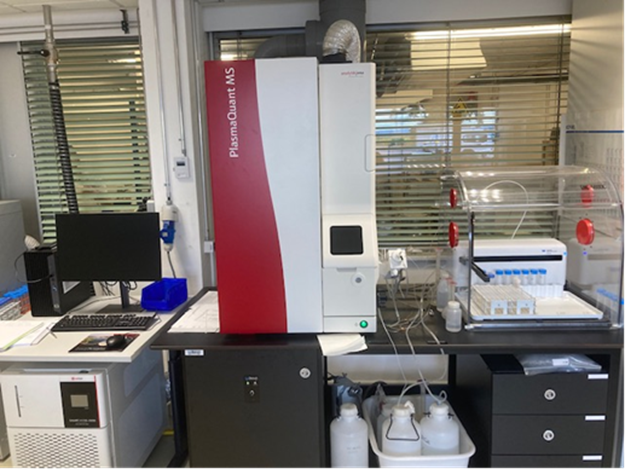
This is TOC/TNb (Total Organic Carbon and Total Bound Nitrogen Analysis by Catalytic High Temperature Combustion) for the quantification of carbon and nitrogen in water:

This is the Ion chromatography instrument for the quantification of anions and cations in water:

And finally, this is AOX (Adsorbable Organic Halides), that gives values that indicate the concentration of organic halogens, which are compounds containing chlorine, bromine, or iodine, in a water sample.
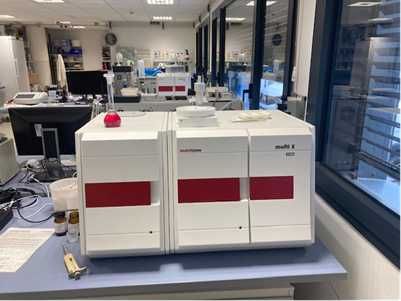
Before the build: preserving soil health and orchid populations at CERN
|
It’s 7:45 a.m. on a grey and damp Monday morning in February, but Jean-Paul Bergoeing (ENV-EP) and a team of SCE personnel and contractors are already hard at work. They are conducting some pre-site works to mitigate the environmental impact of a new build. Jean-Paul explains the significance of such work for CERN and its environment. Photo: The team of specialist contractors delicately replant some 200 orchids in their new home along Route Gentner. |
|
Click here to learn more about development and biodiversity...
Q: What are we seeing here Jean-Paul ?
JPB - We’re here in Prévessin on the future site of a Beryllium processing facility which CERN will need in order to produce key components for the HL-LHC and beyond. It is currently a grassy prairie, and we have two important tasks ongoing today which should help mitigate the impact of this build on its immediate environment.
Firstly, I am conducting an initial state soil survey in order to determine the different soil ‘horizons’ present in this zone – basically the thickness of the topsoil and subsequent layers beneath. Contractors will need to know this to sustainably manage the soil resources on this site during the construction phase of the project.
Then behind us, our colleague Mathieu Fontaine from SCE-SAM-CE and his contractor team are on a rescue mission. They are digging up over 200 orchids currently present in the zone that will be impacted by this project. The idea is to find a suitable location to transplant them, not far from this site, where the necessary conditions are met to ensure they can re-establish.
|
Q: What is the significance of this work? JPB - Protecting biodiversity on our sites is a key part of our environmental prevention efforts and we do it hand in hand with our colleagues from SCE-SAM-CE. Over the last years, we’ve built a strong collaboration and we have regular monthly meetings where we discuss the smartest ways to balance CERN’s growth with the preservation and valorisation of the vast biodiversity that we’re lucky to have. Soil is an important natural resource. It can take thousands of years for healthy, fertile soil horizons to develop. The soil in this area is almost untouched and in very good condition. Applying best practices during the works is therefore essential to ensure the preservation of this valuable resource and to make it possible to reuse it in other developments on our sites. This could be to redevelop areas where topsoil had been mixed in the past during backfilling, or to replace old tarmac when there is permeabilisation work, for example of a parking lot with more trees or green spaces. It can also simply serve when planting trees. Some soil profiles in our sites also provide ideal conditions for rare species of orchids to develop and reproduce. CERN has such a large variety of different orchids (18 species described to date) that they are of great significance to our regional ecology. |
Jean-Paul shows the different soil horizons by laying a soil sample horizontally, with a deep layer of healthy, fertile soil. |
Q: How can we continue to protect our plant biodiversity at CERN?
JPB - The most effective way to protect this richness is to avoid impacting the green spaces where these orchids grow. However, some projects at CERN come with strict technical constraints, and in some cases avoidance is simply not possible.
In these situations, we do our best to maximise the chances of saving the affected orchids. We carry out an exhaustive inventory of the impacted specimens on site and then relocate them following strict protocols and with the support of specialised companies. It can take many years for orchids to establish when grown from seed: many will not grow at all if certain other plants, like essential soil fungi, are not present.
Despite our best efforts, we cannot be sure that every orchid will survive the transplantation. In fact, with Isabel Bejar, project leader for the new Beryllium treatment facility and flora enthusiast, who has closely followed the orchid relocation, we cautiously anticipate only 30-50% of the 200 orchids might survive. However, with so many plants involved even this very low rate of survival is still a significant achievement.
Q: And finally, you are about to take on a new challenge as Geologist for the FCC project, staying in the HSE-ENV group but joining the Special Projects (SP) section, led by Luisa Ulrici. Congratulations! Tell us a bit more about what is next for you in this context and for conservation activities like this at CERN?
JPB - I’m very excited to take on this new challenge as a geologist for the FCC project. After all, I’m a geologist by training, and this new role is, in a way, a return to my roots.
It’s a great opportunity to work on a large-scale project while continuing the efforts we've made in recent years to integrate environmental considerations into our practices. I specifically look forward to collaborating to develop a sustainable solution for the management and reuse of excavation materials, as we design the future underground installations of the FCC.
The mission is clear: to turn waste into a resource, in line with the values of the circular economy and the European principles on waste management. This work requires a serious, creative, and interdisciplinary approach, and I’m pleased to contribute from my field of expertise.
As for biodiversity conservation at CERN, I’m confident in its promising future. People are becoming more aware and are starting to ask increasingly relevant questions. Fortunately, CERN’s environmental protection team has recently expanded with the arrival of our colleague Inès Debit, who holds an MSc in Environmental Science and will strengthen our efforts to keep moving forward in this area.
Projects like the orchid initiative show that well-designed and well-executed concrete actions can truly make a difference. I also believe there are still many avenues to explore at other scales — for instance, initiatives like OpenSkyLab could offer promising solutions to support the implementation of circular economy strategies for managing what was once considered inert waste and transforming it into a living resource.
In short, a new chapter is beginning, filled with exciting challenges and the continued desire to reconcile scientific development with environmental respect. And fortunately, the HSE Environmental Prevention Section led by Sabrina Schadegg has recently expanded with the arrival of our colleague Inès Debit who will focus on biodiversity topics and strengthen our efforts to keep moving forward in this area.



